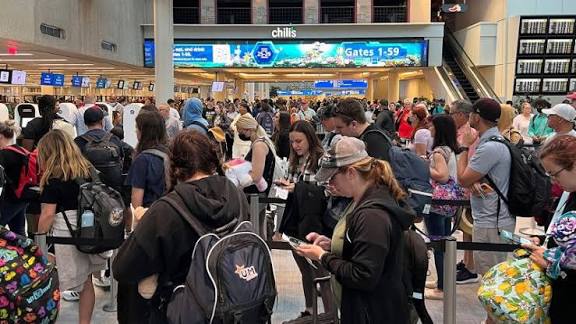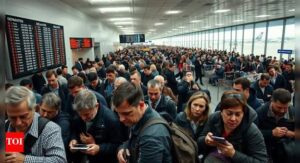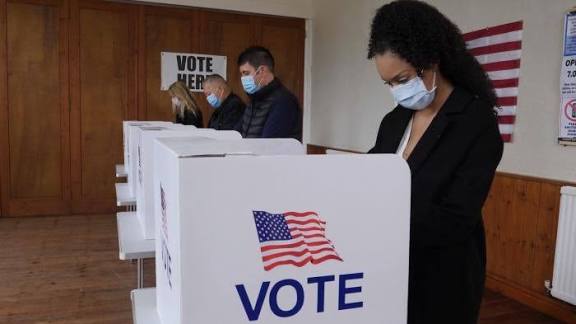TSA Chaos at Airports: Staffing Collapse Leaves Travelers Stranded

An aviation regulator has shared a letter designed to help passengers of a collapsed airline get money back for flights they bought. Today we will discuss about TSA Chaos at Airports: Staffing Collapse Leaves Travelers Stranded
TSA Chaos at Airports: Staffing Collapse Leaves Travelers Stranded
In recent weeks, airports across the United States have become the epicenter of a growing travel crisis — long security lines, cancelled flights, and widespread frustration. At the heart of this upheaval is a staffing collapse within the Transportation Security Administration (TSA), spurred by a deeper systemic crisis. This is not merely a matter of administrative inconvenience; millions of travelers find themselves stranded, delayed, or risking missed flights. The chaos is compounded by a broader breakdown in air traffic control operations amid a government shutdown.
This article unpacks the roots of the crisis, explores how it’s playing out at major airports, examines its human and economic costs, and considers possible reforms to prevent such breakdowns in the future.
The Roots of the Crisis

1. The Government Shutdown and Unpaid Essential Workers
The immediate trigger for the current TSA chaos is the 2025 U.S. federal government shutdown. As part of the shutdown, essential personnel — including TSA officers and air traffic controllers — have been working without pay. The fact that these workers remain on duty despite not receiving compensation underscores the gravity of the situation, but it also has real operational consequences.
TSA officers have missed paychecks, leading to increased absences, callouts, and a significant drop in staffing. Checkpoint closures have followed: for instance, at Houston’s George Bush Intercontinental Airport, only two of the five terminals remained open for screening.
2. Chronic Understaffing and Retention Challenges
While the shutdown has exacerbated the problem, TSA staffing woes did not begin overnight. Historically, the agency has struggled to keep its workforce at optimal levels. A Government Accountability Office report pointed out that in 2023, only about 96 percent of Transportation Security Officer (TSO) positions were filled — still short of what’s necessary to prevent bottlenecks.
Compounding this are retention challenges: TSA officers often cite low pay, difficult working conditions, and limited upward mobility. In some congressional hearings, TSA officials noted difficulty competing with local economic conditions to recruit and retain screeners.
3. Resource Mismanagement at Checkpoints
The fallout is not simply from lack of staff but also from how existing resources are deployed. At New York’s LaGuardia Airport, checkpoint closures and long lines were at least partly due to mismanagement of resources rather than pure shortages. Critics argue that even when personnel are present, inefficient deployment, poor scheduling, or suboptimal lane allocation makes the problem worse.
On-the-Ground Impacts: Airports Under Siege
1. Houston: Lines Stretch to Hours
Houston is among the hardest-hit. At George Bush Intercontinental Airport (IAH), travelers have reported waiting up to three hours in security queues. At times, only two terminals are functional for TSA screening. Such constriction doesn’t just test travelers’ patience — it risks missed flights and a severe erosion in traveler confidence.
2. Atlanta: Security Bottlenecks and Checkpoint Closures
At Atlanta’s Hartsfield-Jackson International Airport, long lines have become a normalized weekly occurrence. Reports note security lines stretching into the atrium of the domestic terminal. On some mornings, wait times have surpassed 40 minutes just before 6 a.m., a clear sign that staffing shortages are not a transient weekend hiccup but a systemic strain.
3. National Scope: Widespread Disruptions
The problem is not confined to one or two airports. Numerous airports around the country are reporting chaotic conditions. TSA sickouts, resource misallocation, and checkpoint closures are compounding delays. Meanwhile, air traffic control shortages are issuing their own havoc: some major airports are experiencing ground stops, and average delays in certain cities are ballooning.
Additionally, staffing shortages now account for a significant majority of flight delay minutes, a stark rise from pre-shutdown levels.
The Human Cost: Stranded, Stressed, and Unpaid
1. Passengers’ Plight
For travelers, the fallout is deeply personal. Long wait lines erode the predictability of travel. Missed connections, stressful dashes through terminals, and cancellations all threaten not just the convenience but also the cost of travel. Many are forced to arrive hours earlier than normal, costing them time, energy, and sometimes lost business or vacation opportunities.
2. TSA Officers Working Without Pay
On the other side of the barrier, TSA officers find themselves in a precarious position: essential employees expected to show up day after day, but without a paycheck. Some have reportedly resorted to gig work, borrowing money, or reducing shifts to cope. One unnamed TSA officer spoke candidly: “People are proud… but there’s only so much you can ask when folks can’t pay their bills.”
3. Airport Operations Under Strain
The knock-on impact ripples through the entire aviation ecosystem. When TSA checkpoints slow down, airlines must adjust, gate operations get disrupted, and ground crews contend with unscheduled delays or sudden surges. For airports, these operational inefficiencies translate into financial strain, reputational risk, and logistical headaches.
Why This Crisis Is Worse Than Past TSA Lines
To understand the gravity of this moment, it’s important to distinguish between historic TSA wait-time complaints and the present collapse.
Scale & Duration
Unlike occasional seasonal surges, this is a sustained, system-wide staffing crisis. The underlying cause isn’t just more travelers — it’s critically reduced manpower because of an ongoing government shutdown.Dual Pressure on Security & Air Traffic Control
This isn’t just a TSA problem. Air traffic controllers are also affected, working without pay, which magnifies the disruption. When both screening and flight management are stressed, the entire system strains.Resource Misallocation
As noted at LaGuardia, even when staff are present, they aren’t being utilized optimally. That suggests managerial and logistical failures, not solely labor shortages.Worker Morale & Retention
For many TSA agents, the shutdown is more than an inconvenience — it’s a financial hardship. The longer this continues, the greater the risk that skilled screeners will either quit or underperform due to burnout or demoralization.
Broader Implications & Risks
1. Safety & Security Concerns
Some might argue that fewer TSA officers could compromise security. While TSA maintains that safety protocols remain in place, sustained understaffing risks cutting corners. Fewer lanes open mean higher pressure on existing personnel, raising the risk of fatigue-related errors or slower threat detection.
2. Economic Disruption
Airports generate significant local revenue, from retail and dining inside terminals to parking and ground services. When travelers spend hours in lines or miss flights, these revenue streams shrink. Airlines, too, face costs in crew overtime, rebooking, and compensation. Longer term, passenger confidence may weaken, making people think twice about flying during uncertain times.
3. Erosion of Public Trust
One of the TSA’s core missions is to provide security while facilitating efficient travel. When it fails on the “facilitate” part, public perception suffers. Frequent travelers, business people, and even casual vacationers may grow wary of the unpredictability. If these conditions persist, they could drive a shift in travel behavior or fuel political pressure to reform or restructure TSA operations.
What’s Being Done — And What More Could Be Done
Current Steps & Responses
Airport Advisories: Many airports are proactively alerting travelers to expect long security lines and encouraging them to arrive early.
Limited Lane Operations: At Houston’s airport, only select checkpoints are open to match the reduced TSA force.
Interagency Coordination: Airports, airlines, TSA, and the FAA are coordinating to manage ground delays, checkpoint closures, and flight scheduling in an effort to balance safety and capacity.
Recommendations & Potential Reforms
Congressional Action & Funding Guarantees
The government must resolve the shutdown swiftly to restore pay for essential workers. Beyond that, legislators could consider more robust contingency funding for critical agencies like TSA, ensuring that essential functions remain staffed even during budget impasses.Improved Staffing Models
TSA should revisit its staffing allocation models. Many checkpoints operate below optimal staffing. A dynamic staffing model — one that flexes based on real-time passenger flow — could help minimize waste and maximize coverage.Retention & Pay Reform
Addressing the root causes of attrition — including compensation, benefits, career progression, and working conditions — is critical. TSA might need to re-evaluate pay scales or incentives to retain experienced screeners, particularly in high-traffic or high-cost cities.Resource Optimization & Better Management
Simply having staff isn’t enough: how they are deployed matters. TSA and airports need to analyze checkpoint usage, traffic patterns, and officer allocation to reduce bottlenecks and ensure better flow.Technology & Automation
Investment in advanced screening tech could help reduce dependence on human screeners. Automated systems — whether in identity verification, baggage scanning, or queue predictive analytics — can supplement staff and make processes more resilient.Public Communication & Transparency
Airports and TSA should proactively communicate with passengers about expected delays, checkpoint status, and staffing updates. Transparency helps build trust and allows travelers to plan better.
What Travelers Can Do Now
While systemic solutions are in progress (or may take time), travelers themselves can take practical steps to navigate the chaos:
Arrive Early: Give yourself plenty of buffer time for security. In affected airports, add at least an extra hour or more.
Monitor Airport Updates: Check airport websites or apps for real-time security lane status, alerts, or advisories before heading out.
Use Trusted Traveler Programs: If available, programs like TSA PreCheck or Global Entry could help, though even these lines may be crowded.
Stay Flexible: Be prepared for delays, rebookings, or even cancellations. Where possible, book flexible tickets or allow a buffer day in your itinerary.
Bring Essentials: Patience, water, and snacks can go a long way when security queues stretch for hours.
Conclusion
The current TSA chaos unfolding at U.S. airports is not just an inconvenience — it’s a serious operational and human crisis. Rooted in the 2025 government shutdown, chronic underfunding, and resource mismanagement, the staffing collapse exposes vulnerabilities in one of the most critical pillars of air travel safety and infrastructure.
Travelers are paying the price with long waits, missed flights, and growing frustration. TSA officers, meanwhile, are working under immense pressure and without pay. The broader aviation ecosystem—airlines, airports, regulators—is straining under the weight of these dual crises.
Solving this problem will require immediate political resolution, but also long-term structural reform: better staffing models, stronger retention strategies, smarter resource deployment, and investment in technology. The goal must be a resilient TSA system — one that can guarantee security and efficiency, even under duress.
For now, the chaos remains real, but it also shines a light on deep-rooted challenges that demand urgent, meaningful action.
How useful was this post?
Click on a star to rate it!
Average rating 0 / 5. Vote count: 0
No votes so far! Be the first to rate this post.
About the Author
usa5911.com
Administrator
Hi, I’m Gurdeep Singh, a professional content writer from India with over 3 years of experience in the field. I specialize in covering U.S. politics, delivering timely and engaging content tailored specifically for an American audience. Along with my dedicated team, we track and report on all the latest political trends, news, and in-depth analysis shaping the United States today. Our goal is to provide clear, factual, and compelling content that keeps readers informed and engaged with the ever-changing political landscape.




